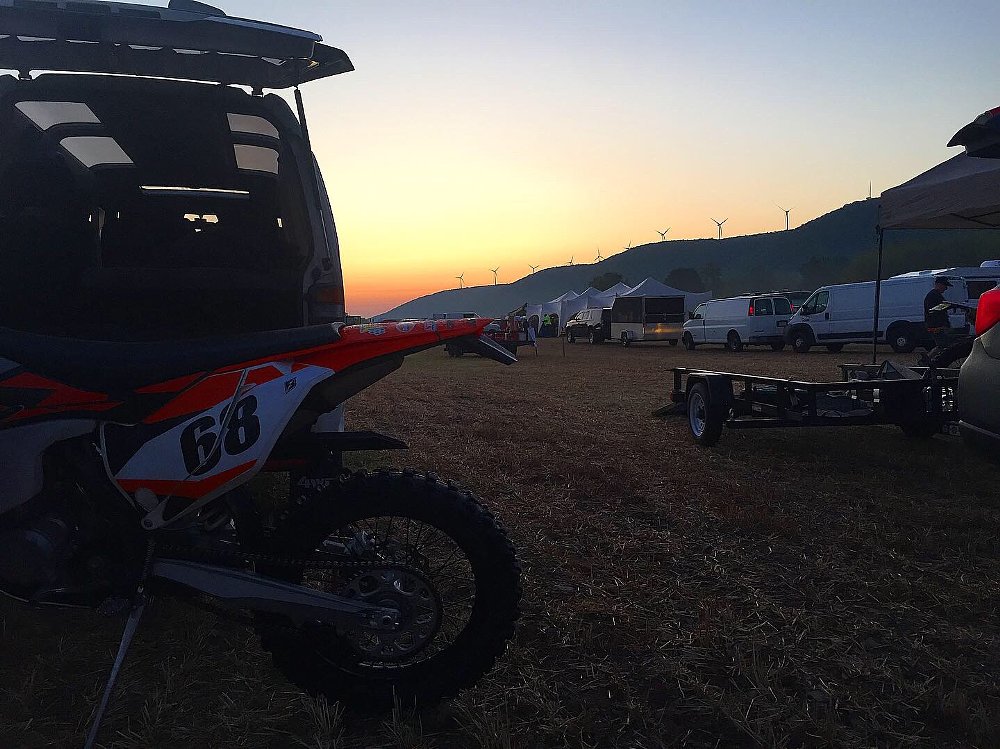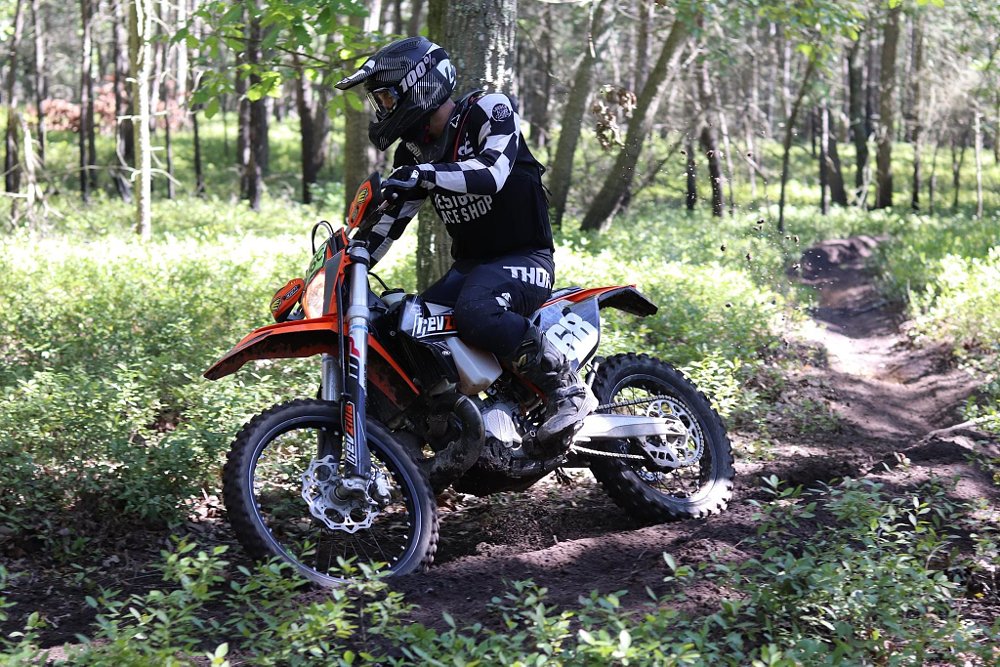So you’ve got a dirt bike and you’re thinking about participating in your first race (see our beginner's guide from two weeks ago) and an enduro sounds like a good time. Where do you start? What do you need to do to run your first enduro?
An enduro is a good way to get into competitive motorcycling because it’s not all about going as fast as you can through the woods. With most other types of dirt bike racing, there is a good chance you’ll be very close to your competition while passing or being passed. With enduros, you will likely find yourself riding solo most of the time. There will certainly be a few other racers nearby and sweep riders on the course, but if bar bangin’ isn’t really your thing, enduros are a perfect choice. They are a great option for riders looking for some competition, with very little risk of getting tangled up with anyone else.
Technically, a traditional enduro is not a race, but a time-keeping event. That said, a capable and fast rider will be more likely to get good results, but only if that rider is also a good time-keeper. A fast rider who blasts past everyone will likely arrive so early at a checkpoint that he or she may earn enough penalty points to come in last place. Conversely, a slow rider who is an excellent time-keeper may manage to keep the penalty points to a minimum, ending the day with surprisingly good results.
Enduro riders need the mental and physical endurance to ride all day and stay “on time” to receive as few penalties as possible. They do that by using their clock, roll chart and odometer. A simple analogy is imagine a normal day of running errands. You need to get to the bank when it opens at 9 a.m. so you can meet a friend for coffee at 9:30 and you need to wrap that up early enough to get to your doctor's appointment at 10. You don’t want to be late or early to any of these.
At this point, you might be saying “This does not sound very fun, Joe. Why the hell would I want a day of riding to feel like I’m running errands on a tight schedule?”
I have no good answer to that question, but I swear enduros are extraordinarily fun and challenging. So let's look at what you need before you sign up for your first enduro.

Dirt bike
Be sure to check with the organization before signing up to see what your bike needs to pass tech inspection. Some events are held on public land and roadways so spark arrestors, lights, registration and insurance are required. Others are held on private property where the bikes do not need to be street-legal. In either case, be sure the bike is in good condition so it is able to cover a hefty amount of off-road miles without breaking down or falling apart. Good tires, chain, sprockets and brakes are high priorities.
Clock
Admittedly, it took a few enduros for me to finally understand how time-keeping works. Key time is the time that the first riders take off from the starting line, typically 8 a.m. Rows of three to five riders will go off in one-minute intervals after them. Since the goal is for every rider to arrive at checkpoints at the exact time specified by the roll chart, all riders set their watches to the key time minus their row number, which is also the number of minutes they will start after the first row goes off. If you are assigned row 30, you will set your clock to 7:30 when the first riders go off at 8:00. That means you will leave the starting line when your clock says 8:00. In a perfect enduro, no rider would pass or be passed by any riders from any other row. It sounds more confusing than it is.
Roll chart
Directions on your roll chart will coincide with course markings consisting of directional arrows and signs showing W for wrong way and X for danger. Your roll chart will show you directions in abbreviations like “LBT” for left on blacktop or “RWT” for right on woods trail. Your roll chart will also show the average speed for a particular section. You may think “24 mph is so slow for this paved section!” Then you find yourself heading into single-track that's so tight that you can barely break 10 mph. Remember, it's average speed, not the speed limit. That said, never break the posted speed limit during the on-road sections of enduros. Not only does that reflect poorly on our sport and the organization holding the event, you will also end up showing up too early to a checkpoint and earn a pile of penalty points or possibly face disqualification.
Odometer
The roll chart also shows mileage and minutes. Each line on your roll chart will tell you what time it should be when you’ve traveled the distance shown. For instance, during a 24 mph average section, you should travel four miles in 10 minutes. If your odometer shows four miles have been traveled in more or less than 10 minutes, you know if you should speed up or slow down to get back on time. The roll chart will also show “resets” where you need to program your odometer to the mileage specified. This makes up for differences between bikes’ odometers, tire sizes, line choice, etc. and ensures that everyone stays on the same mileage. It also adds to the challenge of time keepers. If you miss a reset, everything will be off.
So you’ve got a reliable dirt bike, a cheap watch, a roll chart holder and a resettable odometer. What else do you need to prepare for an enduro?
Endurance
As the name suggests, an enduro requires endurance. You will be hyper focused on riding rough terrain and keeping track of your time and mileage all day. If you normally find yourself feeling gassed after an hour or two of riding with your buds, I suggest some physical training by slowly building up your ride duration before entering an enduro that may take six to eight hours to complete. That said, parts of some enduros are relatively easy riding, while others are pretty darn difficult the entire day. I personally watch riders' GoPro videos from previous years to get a good idea of how hard or easy an enduro may be.
Riding gear
I recommend comfortable protective riding gear. I personally wear a well ventilated off-road helmet, fog-resistant goggles, a neck brace, full body armor, knee braces and dirt-specific riding boots. Thankfully, I’ve been riding off-road for a while now and managed to build up a very protective set of kit that is comfortable to wear all day.
It took a lot of experimenting with different gloves and grips to find the perfect setup allowing good control of the bike without tearing my hands to shreds. Spare gloves are also nice to replace wet ones as the day unfolds. A good base layer designed for the temperature you’ll be riding in is important. This protects your skin from chafing. The difference between wearing riding gear for a couple hours versus eight hours is huge.
I also suggest starting your day feeling a little cold, so as temperatures inevitably warm up, you won’t become overheated. Storage is obviously limited so packing away a heavy jacket after five miles is less than ideal. A windbreaker that packs down nice and small is usually enough. If it is a muddy course, I suggest roll-offs for your goggles since we don’t want to be leaving any tear-offs in the forest.
Supplies
Tools, water and snacks are also important for these long days on the bike. I use a hydration pack with enough room to carry all three. I also use some hydration enhancing powder in my water, which has honestly been a game-changer for me this past race season. It helps prevent muscle cramps and adds a little flavor to keep you sipping throughout the day. It is always better to take small sips of water versus chugging, since you sure do not want to have to stop for a pee break every 15 minutes. As for snacks, think trail mix (I like the kind with M&Ms for a little extra sugar) or granola bars. Save the spicy beef jerky or roadside chilidogs for after the enduro.
Fuel
A fuel jug is also required to ensure you can cover the required miles to complete the enduro. In most cases, the event organizer will offer a truck and trailer for you to place your extra fuel on before you begin your ride. They will cart it to the designated fuel stop(s) shown on your roll chart. An enduro will never require riders to cover so many miles between fuel stops that they risk running out, even with the stock fuel tank on enduro bikes. Now, if you’re running a hopped up 450 cc MX bike with a tiny tank, you may want to carry some spare fuel with you.
Pro tip: Write your name, bike number and/or put some unique stickers on your fuel bottle. Paint the top a silly color, since trying to find your fuel bottle in a sea of a hundred that all look alike is a time waster. I would rather find my fuel immediately, get it in my bike and spend the extra few minutes resting and snacking before it's time to take off again.
Friends (optional)
If possible, get a friend or two to sign up with you and request the same row. You will be riding with the other folks on your row all day, so it is nice to bring a friend along. If not, you will likely have made some friends throughout the day.
There is nothing like the feeling of completing an enduro. Even if your results are so-so, just finishing in one piece is incredibly rewarding. There is no harm in giving some enduros a shot without even caring about the time-keeping aspect of it. The best way to learn is to figure it out slowly on your own, even if it takes several tries. Once you figure out how to make it to most checkpoints on time, you’ll really feel like a champ, regardless of how long you’ve been riding or which class you’re in.
For a deeper dive into the elusive and mysterious world of enduros, check out your local enduro club’s website. Ours is the East Coast Enduro Association. The AMA has some good info as well. Then get out there and take on your first enduro.





























